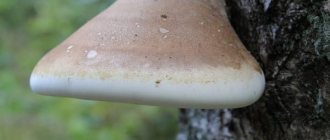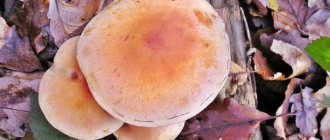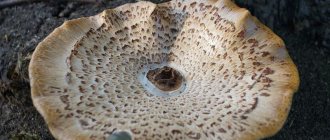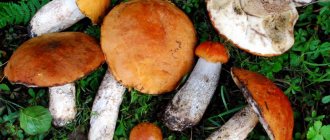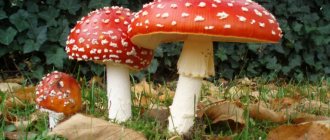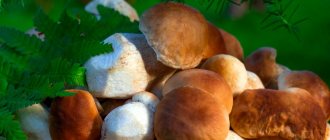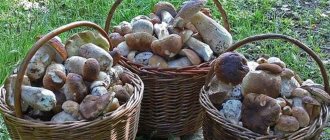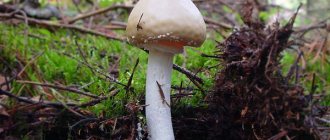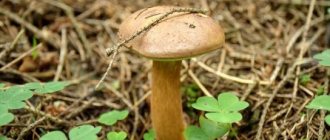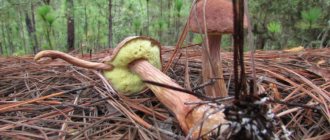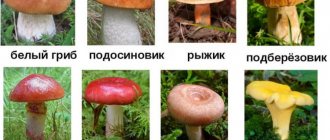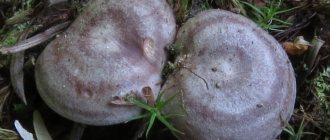The mushroom varies in color from white to dark brown and grows in many places in the world where birch trees grow. It grows only on birch trees, so it is difficult to confuse it with another fungus of the tinder fungus.
It is found everywhere in Russia. The mushroom has many uses in everyday life and in medicine.
It is not used in food because of its bitter taste, although the mushroom is not poisonous.
| Common name: | Birch polypore |
| Scientific name: | Piptoporus betulinus |
| Season: | August - November |
| Height: | about 6 cm |
| Weight: | about 30 grams |
The fungus grows on dead or damaged birch trees. Sometimes it is found on healthy trees, and parasitizes them, resulting in the death of this tree. It has the usual mushroom taste, but with a bitter aftertaste.
The mushroom contains the following components:
- Ascarbic acid;
- Polyporenic acids;
- Hydroquinone;
- Indole alkaloids;
- Piptamine, a Stone Age antibiotic;
- Tocopherol (Vitamin E);
- Beta carotene;
- Various B vitamins;
- Vitamin C;
- Iron, phosphorus, copper, selenium, potassium;
- Fatty acids, 77% of which are unsaturated, mainly oleic and linoleic acids
- Betulinic acid;
- Polyphenols;
- Beta glucan.
It has many uses both in folk medicine and in everyday life.
No medications are made based on it and official medicine does not use it, so be sure to consult your doctor before using it.
Use in folk medicine
Birch polypore in folk medicine can be used as a tonic for the immune system, used as an antiseptic for treating wounds and promoting their healing. To prepare various infusions, only young mushrooms with a white bottom are used, pictured below:
Perhaps in ancient times it was used to get rid of parasites.
Interesting fact:
In 1991, a frozen corpse was discovered by Austrian tourists in the Tyrol region of the Italian Alps. It turned out that it was a 5,300-year-old mummy, which was given the name Otzi.
A birch tinder fungus was found on a leather strap around the mummy's neck, and a study of the mummy showed the presence of E. coli in the body, which can be cured with polyporenic acid, which is also present in the tinder fungus.
The mushroom contains many health benefits such as betulinic and polyporenic acid.
We recommend: Leocia gelatinosa
A study of birch polypore in Western countries showed that the substances found in the fungus can be used for the following purposes:
- Antivirus. In tests, birch polypore extracts blocked the proliferation of HIV cells, protected against encephalitis, and in the treatment of influenza and yellow fever.
- Antibiotic. Birch polypore contains the antibiotic piptamine, which has been used to treat E. coli.
- Anti-inflammatory agent. Contains several triterpene acids, which are known as anti-inflammatory agents.
- Antitumor agent. Betulinic acid and other chemicals in mushrooms have been shown to cause apoptosis, the destruction of cancer cells, without affecting healthy cells.
- Antiseptic. To clean wounds and assist in healing.
- Antifungal. This fungus does not like to share its habitat with other fungi and has powerful antifungal agents.
The mushroom has a very beneficial effect on the immune system; many people drink tea made from fresh or dried mushrooms and report its positive effects.
Edible mushrooms growing on a birch tree
In addition to Chaga, there are many birch mushrooms that also grow directly on the trunk. Oyster mushrooms and honey mushrooms are widely known and are often used in cooking to prepare various dishes. Among the oyster mushrooms there are no inedible or poisonous species, but the photo and description of the honey mushroom, for example, must be studied carefully in order to be able to distinguish it from the false one.
Oyster mushroom
Oyster mushrooms get their name because the fruiting bodies hang from the trunks of birch trees. They are not only tasty, but also healthy, which is why housewives often use them to prepare various dishes. There are many varieties of oyster mushrooms, and the most popular are ordinary, carob-shaped, pulmonary and orange.
Oyster mushroom or oyster mushroom is a large mushroom, the diameter of the cap reaches 30 cm. It is shell-shaped in shape, with edges directed inward and a smooth surface. Later it becomes flat.
The color is variable, it can be dark gray with a brown tint, ashen with a slight purple tint. The leg is short, curved, light. The pulp of the fruit part is light and soft, and becomes tougher with age. You can see the common oyster mushroom from early autumn to early winter.
You may be interested in:
How to distinguish real saffron milk caps from false mushrooms (28 photos)? Saffron milk caps are a popular forest delicacy in our country with an exquisite taste. Their taste qualities are not inferior to...Read more...
Oyster mushroom
The corniculate oyster mushroom differs from the previous one in that it has a smaller and funnel-shaped cap. The color is almost always light, with a grayish tint. The pulp is white and fleshy, odorless and tasteless.
Horn-shaped oyster mushroom
Pulmonary oyster mushroom has a thin tongue-shaped cap, with cracked edges, beige in color, the diameter of which reaches 8-9 cm. The lamellar part is descending. The pulp is always thin and elastic. The leg is almost invisible; it has slight pubescence.
A distinctive feature of the orange oyster mushroom is the bright orange color of its fruit part. The cap grows to the tree sideways, so most often it has an irregular shape with wavy edges. The surface of the cap is pubescent.
This variety has no stem completely, and the plates are large, wide, and orange. The taste and smell are weak putrid. The mushroom is considered inedible due to the fact that it is quite hard and has a specific taste and smell. Despite this, young fruits are still eaten.
You may be interested in:
What is the name of a mushroom with a red cap and its description (24 photos) Very often, mushroom pickers encounter many different mushrooms with a red cap in the forest. They usually look very...Read more...
Edible honey mushrooms
No less common are honey mushrooms. They are often used in cooking and are valued for their taste. They are divided into summer, autumn and winter depending on the peak of yield.
Summer honey mushrooms have a thin cap with edges turned inward, which straighten with age. The hat is colored yellow with a brown tint. The diameter of the cap does not exceed 8 cm, and centric water circles may appear over its entire surface. Over time, the circles disappear.
On the inside of the cap there is a plate system that becomes darker over time. The leg is tall, brown and thin, has a ring and scales located below it. You can see summer honey mushrooms from July until the first snow.
Autumn honey mushrooms are distinguished by a flat cap with wavy edges, colored green-brown. The pulp of autumn honey mushrooms is soft, dense and white. The leg is tall, widened at the base, and covered with scales. You can see autumn honey mushrooms from the end of August to the end of autumn.
Winter mushrooms cannot be confused with anything, since the surface of their cap is glossy, light brown in color with a reddish tint. It is convex in shape. The pulp is thin and tough, mostly white. The leg is cylindrical, 8 cm in height, light brown in color. You can find this variety from the onset of cold weather until the beginning of spring.
Household use
- From the white porous bottom surface, you can prepare a plaster that will have antifungal, antiseptic and self-adhesive properties.
- The mushroom was used by barbers for the final sharpening of straight razor blades.
- The mushroom was also used in the past as a very fine sandpaper for polishing metals, and was used to make ink and mounting bases for insect collections.
- It was used as tinder for starting fire, including for transporting it when moving from camp to camp.
- Can be used to repel mosquitoes, you need to cut them into slices, dry them and then simply set them on fire, mosquitoes are afraid of smoke and do not fly up.
A plate of dry tinder fungus must be fixed and set on fire; mosquitoes are afraid of smoke and do not fly up.
Contraindications
The beneficial properties of tinder fungus were appreciated by both practicing doctors and ordinary people. At the same time, it does not have an absolutely harmless composition and can cause serious damage to health. It is prohibited to use piptoporus in the following cases:
- pregnancy and lactation;
- rehabilitation after abdominal surgery;
- severe form of colds;
- age up to 12 years.
Important! You can take medications based on birch mushroom only after consulting a specialist. Exceeding the required dosage is fraught with vomiting and poisoning.
You need to take the same responsibility when consuming alcohol tinctures. They are a good addition to the main treatment, but cannot completely replace it. Birch polypore has many vitamins and nutrients, but requires an extremely careful approach to use.
When to collect and how to process:
You should only collect mushrooms that have a white bottom. Collect the mushroom from young birch trees; if the mushroom has black and brown spots, it is not recommended to use it. Can be collected all year round. The best season is between September and December because during this time it develops new fruiting bodies.
We recommend: Sarcosoma globulus mushroom
In folk medicine, the mushroom is used fresh and dry. To dry it, simply cut it into small cubes or slices and simply dry it naturally. When dry, it can be stored for many years.
(Pictured is an old tinder fungus, not suitable for medical use, but excellent for driving away mosquitoes, illustration to demonstrate cutting for drying)
Flat polypore has medicinal properties. Ganoderma flat, tinder fungus flat
LATIN NAME: Ganoderma Upsiensis (Batsch) GF Atk, Ganoderma applanatum (Pers.) Pat, Boletus Upsiensis Batsch
RUSSIAN NAME: Ganoderma flat, tinder fungus flat
CHINESE NAME: Flat polypore, old ox liver, wooden ear
TAXONOMIC POSITION:
- Class: Basidiomycetes
- Order: Aphyllophorales
- Family: Ganodermataceae
MEDICINAL RAW MATERIALS: Fruiting body
Morphological features
Basidiomas are perennial, solitary (occasionally growing in twos), located one under the other, sessile, greatly varying in size depending on the habitat, usually basidiomas reach a diameter of 50-400 mm or more (occasionally more than 600 mm) and 15-120 mm in diameter. thickness at the base. Basidiomas are flat, half-shaped, occasionally tongue-shaped, so that the width exceeds the length, very rarely almost hoof-shaped or nodule-shaped. The surface of the cap is uneven, wavy, often tuberculate, covered with a thin, soon hardening and thickening crust, shiny when cut, initially whitish-grayish, then darkening, often brown from the spores covering it.
The edge is straight, thin, blunted or rounded, initially whitish, gray or leathery-yellow above, later the same color as the rest of the surface, sterile below. The tissue is hard, corky, elastic, unclearly zoned, felt-fibrous when torn, from thin to rather thick, reddish-brown, often with white dotted discolorations interspersed with tufts of colorless hyphae. The tubes are layered, often with noticeable thin layers. The surface of the hymenophore is white, then yellowish, turning brown when touched, becoming darker with age. The pores are entire, round, small, 4-6 per 1 mm. The hyphal system is trimitic. Generative hyphae are hyaline, thin-walled, septate, with buckles, poorly visible in the basidioma tissue. Skeletal hyphae are brown, very thick-walled to almost solid, 4-6 microns in diameter, highly branched. The connecting hyphae are few in number. Basidia 10-13×7-9 µm. The spores are ellipsoidal-ovate, truncated at the apex, 6.5-8.5×4.5-6 µm, with a double shell. Spore powder is brown.
